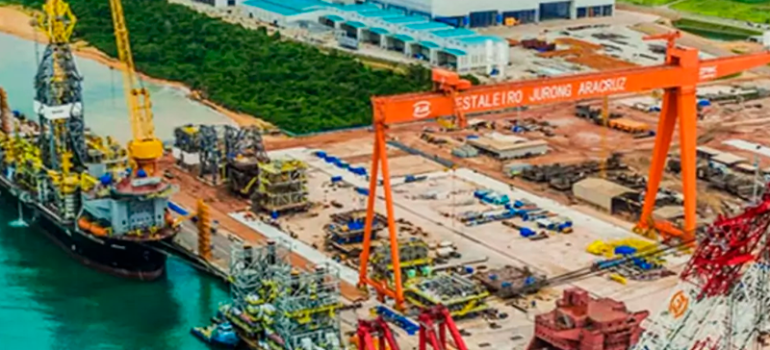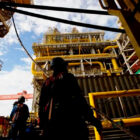Desde 1995 o setor industrial capixaba vem realizando investimentos na ampliação das suas plantas instaladas no estado nas décadas de 70 e 80. Visando a inserir os fornecedores e trabalhadores locais na execução desses projetos o SINDICON, SINDIFER, SINDICOPES, SINAENCO e o CDMEC, com apoio do SEBRAE, BANDES, GERES, IEL/FINDES e Governo do Estado, criaram o programa de “POTENCIALIZAÇÃO DO FORNECIMENTO LOCAL”, coordenado pelo IEL. O trabalho deu resultado, transformando-se no “PDF – PROGRAMA DE DESENVOLVIMENTO DE FORNECEDORES”, atualmente coordenado pelo SINDICON, com a participação de 580 empresas capixabas que empregam mais de 35 mil trabalhadores.
O PDF – Programa de Desenvolvimento de Fornecedores tem por objetivos:
- Capacitar, certificar e promover trabalhadores e empresas locais;
- Assessorar os fornecedores locais no acesso ao mercado;
- Reduzir custos para as empresas compradoras, e.
- Gerar emprego e renda nas regiões, melhorando a qualidade de vida.
O PDF tem por filosofia propiciar a realização de negócios dos pequenos fornecedores com as grandes empresas, detentores de tecnologia e também realizar parcerias entre as próprias empresas locais, promovendo um crescimento em onda de toda a economia.
As empresas locais participantes do PDF são classificadas por setor de atuação, a saber: Fabricação e Montagem, Construção Civil, Engenharia de Projetos e Tecnologia da Informação, Serviços e Indústria em geral e Comércio.
No inicio do PDF foi observado que a maior dificuldade para participação local nos projetos estava na má qualificação da mão de obra local, que não atendia aos parâmetros exigidos pelo mercado local – grandes empresas e empreiteiras. A partir dessa constatação, foi realizado um intenso trabalho de mobilização envolvendo fornecedores, compradoras e entidades de ensino, em especial o SENAI , CEFETES e SEBRAE, para preparar o pessoal local visando a atender às demandas que surgisse, evitando a importação de mão de obra como no passado, levavam os rendimentos e deixavam bolsões de pobreza.
Dentre outros foram realizados treinamentos na área administrativa, com cursos de Atendimento ao Público, Técnicas de Vendas, Orçamento de Obras, Técnicas de Liderança, Secretária, Estoquista e Administração da Pequena Empresa.
Também foram feitos treinamentos técnicos para Construção Civil (Pedreiro, Armador, Carpinteiro, Instalador Hidráulico, Eletricista Instalador, Pintor de Parede, entre outros). E ainda para mecânica (Caldeireiro, Mecância Montador,Ajustador, Soldador, Serralheiro, Mecância de Automóveis, Pintor Industrial, Torneiro, Motorista de Equipamentos Pesados, Mecânico de Refrigeração, entre outros).Para Elétrica (Eletricista de Força, Eletricista Montador e Automação e Controle).
Este trabalho é realizado em estreito relacionamento com o SINE-ES – Serviço Nacional de Emprego ligado a Secretaria de Estado do Trabalho e Ação Social. Os trabalhadores devem ser residentes nas regiões de abrangência dos projetos e recebem certificados de conclusão. Os cursos incluem aulas de Segurança, Higiene, Limpeza, Meio Ambiente, Matemática e Noções de Leitura de Desenho.
Estudos realizados pelo PDF para os três principais setores que compõem o programa Fabricação e Montagem, Construção Civil e Engenharia de Projetos, mostram a evolução dos fornecedores capixabas no período de 1997 a 2007. No setor de fabricação e montagem o número de empresas passou de 35 para 55. O de empregados subiu de 3320 para 8340. A mão de obra qualificada subiu de 30 para 46% e o pessoal de nível superior passou de 7 para 10,5%.
No setor de construção civil industrial o número de empresas passou de 35 para 45 e o pessoal empregado subiu de 4900 para 6600. A mão de obra qualificada passou de 47 para 51% e o pessoal de nível superior subiu de 3 para 6,4%. No setor de engenharia de projetos foi onde se observou o maior crescimento. O número de empresas passou de 12 para 41 e o número de funcionários subiu de 301 para 2140. A mão de obra qualificada passou de 43 para 46% e o nível superior subiu de 38 para 50%.
Nos últimos investimentos realizados estiveram trabalhando nas obras cerca de 15 mil trabalhadores por mês. Para os anos de 2009 a 2012, com investimentos previstos superiores a US$ 20 bilhões, o número de empregos diretos nas obras deve ser superior a 30 mil.
Preocupado com esse incremento o Governo do Estado, em parceria com a iniciativa privada e Governo Federal, vem realizando investimento em escolas nos diferentes municípios onde serão implantados os projetos.
O SENAI com unidades em funcionamento nos municípios de Vitória, Serra, Vila Velha, Linhares, Colatina e Cachoeiro de Itapemirim oferecendo cursos profissionalizantes que atendem as diferentes áreas de trabalho. Está em fase de implantação de 3 novas unidades, em Anchieta, Aracruz e São Mateus, além de 16 Agências Municipais. Tem por objetivo atender a todos os municípios que tem mais de 30 mil habitantes, tendo como visão ser reconhecida como entidade importante para o desenvolvimento do estado.
O CEFETES conta com seis Unidades de Ensino em funcionamento , nos municípios de Vitória, Colatina, Serra, Cachoeiro de Itapemirim, São Mateus e Cariacica.Estão em implantação mais sete unidades , sendo que cinco devem começar a funcionar em 2008 nos municípios de Nova Venécia, Aracruz, Linhares, Venda Nova e Guarapari. Para 2009, a previsão é de que devam começar a funcionar as Unidades de Ibatiba e Vila Velha.
Empresários privados tem investidos em diversos curso técnicos, oferecendo diferentes alternativas de qualificação e aprimoramento da mão de obra local, atendendo ao pessoal de nível técnico e superior, com cursos técnicos e de gestão.
Sabemos que muito foi feito, mas precisamos fazer mais para acompanhar a velocidade que os investimentos estão exigindo para não perdemos essa excelente oportunidade de negócios e empregos gerada no estado do Espírito Santo.


















